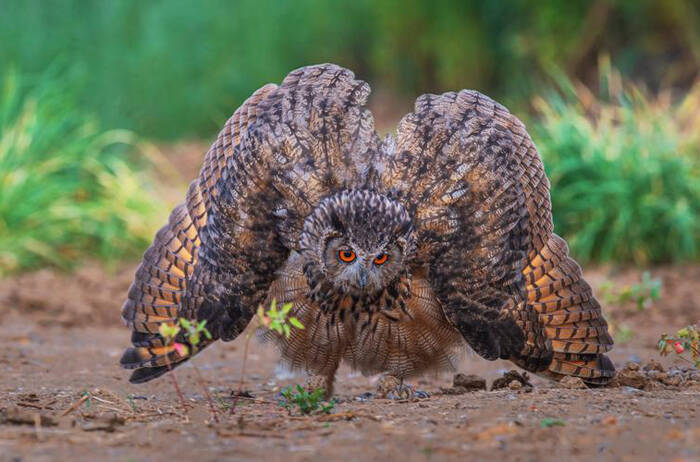Bubo bubo
IUCN
LCBasic Information
Scientific classification
- name:Bubo bubo
- Scientific Name:Eurasian Eagle-owl,Eagle owl, eagle owl, horned owl, eagle owl, fish owl
- Outline:Raptor
- Family:Strigiformes E.Owl
Vital signs
- length:55-89cm
- Weight:1.025-3.959kg
- lifetime:About 20 years
Feature
The second largest owl in China
Distribution and Habitat
Origin: Afghanistan, Albania, Andorra, Armenia, Austria, Azerbaijan, Belarus, Belgium, Bosnia and Herzegovina, Bulgaria, China, Croatia, Czech Republic, Denmark, Estonia, Finland, France, Georgia, Germany, Greece, Hungary, India, Iran, Iraq, Israel, Italy, Japan, Kazakhstan, North Korea, South Korea, Kyrgyzstan, Latvia, Lebanon, Liechtenstein, Lithuania, Luxembourg, Moldova, Mongolia, Montenegro, Nepal, Netherlands, North Macedonia, Norway, Pakistan, Palestine, Poland, Portugal, Romania, Russia, Serbia, Slovakia, Slovenia, Spain, Sweden, Switzerland, Syria, Tajikistan, Turkey, Turkmenistan, Ukraine and Uzbekistan.
Non-breeding: Bahrain.
Wandering: Gibraltar.
Eagle Owls live in mountain forests, plains, wilderness, forest edge scrub, sparse woods, and exposed mountains and cliffs. In Xinjiang and Tibet, the habitat altitude can reach about 3000-4500 meters.
Appearance
The face of the Eagle Owl is conspicuous, light brown, mixed with fine brown spots; the front of the eye and the edge of the eye are densely covered with white bristly feathers, and each feather has black end spots; there is a large black spot above the eye, and the rest of the face is pale Brownish white or chestnut brown, covered with fine brown spots. The wrinkled collar is dark brown, the two feathers are brown, the top of the head is dark brown, the feathers are brown and white, mixed with black wavy fine spots; the ear feathers are particularly developed, significantly protruding on both sides of the head, 55-97 mm long, and the outer side is Black, brown inside. The back neck and upper back are brown, each feather has thick dark brown feather shaft lines, and the two end feathers are decorated with dark brown spots; the shoulder, lower back and upper wing coverts are brown to gray brown, mixed with black and dark brown Stripes or horizontal spots, with thick black feather trunk
Details
The eagle owl is called Eurasian Eagle-owl in foreign language. It is a nocturnal bird of prey with 17 subspecies.

Eagle owls usually stay away from people and live in remote places where few people go. They often act alone except during the breeding season. It is nocturnal and usually hides in dense forests during the day. It rests on trees with its neck retracted and eyes closed, and does not move. However, it has a very keen sense of hearing. When it hears a sound, it immediately stretches its neck, opens its eyes, turns its body, and observes the surroundings. If it finds a person, it will fly away immediately. It flies slowly and silently, usually flying low to the ground. Its hearing and vision are extremely sharp at night. It rests in dense trees during the day. Indigestible mouse hair and animal bones will be vomited out by the eagle owl and discarded around the resting place, which is called a food ball. At night, the eagle owl often makes a "hen, hu, hen, hu" call to communicate with each other. When it feels uneasy, it will make a loud "da, da" sound to threaten the other party.
The breeding season of eagle owls varies from region to region. The breeding season in Northeast China is from April to July. In Sichuan, the breeding season starts from December. At this time, male and female birds roost together in pairs, chasing and playing with each other at dawn or dusk, and occasionally making calls to each other. Mating will take place 3-5 days later, and the female bird will start to build a nest about 1 week after mating. Usually, the nest is built in a tree hole, a concave place under a cliff, or directly on the ground. The female bird digs a small pit with her claws. There is no padding in the nest. After laying eggs, it is padded with sparse down feathers. The size of the nest varies depending on the nesting environment. Each nest lays 2-5 eggs, and 3 eggs are more common. The eggs are white, oval in shape, 55-58 mm x 44-47.2 mm in size, and weigh 50-60 g. The female incubates the eggs for 35 days.
In Europe, the estimated breeding population of the eagle owl is 18,500-30,300 pairs, equivalent to 36,900-60,600 mature individuals (BirdLife International 2015). Europe accounts for about 20% of the global range, so a preliminary estimate of the size of the global eagle owl population is 180,000-300,000 mature individuals, but further verification of this estimate is needed. Therefore, the eagle owl population is placed in the range of 100,000-499,999 mature individuals.
The trend of the eagle owl population is suspected to be declining. The European population is estimated to increase (BirdLife International 2015). However, the Asian population has apparently experienced a significant decline since the 1970s (Holt et al. 2013).
On September 16, 2022, two eagle owls, a national second-level protected animal, were released into the wild in Liancheng National Nature Reserve, Gansu.
Listed in the IUCN Red List of Threatened Species in 2016 ver3.1 - Least Concern (LC).
Listed as a Class II protected animal in the CITES II of the Washington Convention.
In 1989, it was listed as a Class II protected animal in China's National List of Key Protected Wildlife.
In 1996, it was listed as a rare species in the China Red Book of Endangered Animals (birds).
Protect wild animals and eliminate game.
Maintaining ecological balance is everyone's responsibility!








